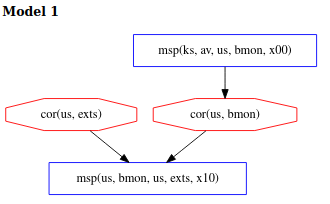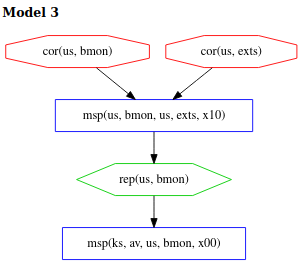Copland
Semantics, languages and tools for layered attestation
- Tampering Paper
- Copland Collection Updated
- CHASE Tutorial Updated
- Maat Released
- CHASE Tutorial Added
- Flexible Mechanisms Paper Published
- Automated Trust Analysis Paper Accepted
- MEMOCODE Paper Accepted
- NFM '21 (Virtual) Conference Presentation
- Copland Collection Released
Publications
Documentation
Software
Blog
Example 1
*bank: @ks[av us bmon] +~+ @us[bmon us exts]
This example shows two measurements taken in parallel, indicated by the ~ operator. The bank issues separate requests for measurement to av and bmon and forms the final evidence by joining the results. Allowing the measurements to happen in parallel has the effect of leaving the ordering of these events unconstrained. Therefore, the measurements can happen in any order. This is illustrated in the figure below through the absence of arrows between the two measurements.

In the left measurement specification, bmon in us measures exts, also in us. On the right, av from its place in ks measures bmon in us. We can easily see the motivation to choose these measurements: if the better-protected av reports that bmon is regular, bmon’s measurement of exts can be reasonably trusted to be accurate. As discussed in detail below, applying no precendence relationship between the two measurements opens this attestation up to easy subversion by the adversary.
The Chase models below are obtained with the following ex1.gln file:
[ bound = 500, limit = 5000, input_order ]
% Assume adversary avoids detection at our main measurement
% event. Others can be added.
l(V) = msp(us, M, us, exts, X)
=> corrupt_at(us, exts, V).
% Assumptions about system dependencies.
depends(ks, C, ks, av) => false.
depends(us, C, us, bmon) => false.
depends(us, C, us, exts) => false.
% Axioms stating "deep" components cannot be corrupted:
% This analysis allows all "deep" corruptions, so there are no axioms here.
% Axiom defining which components cannot be recently corrupted:
% This analysis allows all "recent" corruptions, so there are no axioms here.
m4_include(`ex1.gli')m4_dnl
m4_include(`ex1_dist.gli')m4_dnl
m4_include(`thy.gli')m4_dnl
The herald present at the top of the .gln file is described in the main README and is used to set Chase execution parameters. The next line of the .gln file
l(V) = msp(us, M, us, exts, X)
=> corrupt_at(us, exts, V).
defines the assumption that the adversary avoids detection at our main
measurment event, in our case at the measurement of exts. The
logical quantifiers in the statement are left implicit. All variables
before the => are universally quantified. Any variables after the
=> that are not bound by the universal quantifier are existentially
quantified. Thus the formula above says that for every event V, if V
is labeled msp(us, M, us, exts, X), then exts (in userspace) is
corrupt at V. Since our analysis assumes the evidence passes appraisal,
this means the adversary avoids detection at V. For more information please
see the section on input syntax
here or view the
full Trust Analysis of Copland Specifications
paper. Next,
the 3 dependency assumptions state that av, bmon and exts do not
have any components they depend on. We will skip the axioms for
defining deep and recent corruptions since for this example we are
allowing the adversary to perform both deep and recent
corruptions. The formation of these axoims are described in examples
later in the tutorial. Finally, the m4_include statements at the
bottom of the .gln file link in the other files needed for Chase.
Analysis
Unfortunately, applying no constraints to the precedence relationship between the two measurements opens this attestation up to easy subversion by the adversary. In model 1, we see the scenario where the adversary corrupts exts and then performs a corruption of bmon after it is measured by av (yielding a regular measurement) and then before bmon measures exts, allowing the adversary to avoid detection by using the corrupt bmon to report exts as regular. We refer to the corruption of bmon as a recent corruption since its corruption occurs in a narrow timeframe between two measurement events.

Model 2 shows the case where exts, bmon and av have all been corrupted before the attestation begins. In this instance, each measuring component will report a regular state for each of the measured components, allowing the malicious extentions to go undetected. In this example, we refer to the corruption of av as a deep corruption, since because of its location in kernel space, it is considered better protected.

Finally, in model 3 the adversary succeeds by corrupting
both bmon and exts before the attestation begins. But in order to avoid
detection at the measurement of bmon by av, the adversary relies on the
possibility that this measurement could happen after the measurement of exts,
providing an opportunity to repair bmon after it performs its measurement,
but before it gets measured itself.

How difficult is this to achieve? The adversary had to corrupt bmon, a realtively less-protected component, without time constraints, as well as repair bmon. Both actions are easy to carry out. The reason it is viable is a consequence of insufficiently constraining measurement precedence. Measurement order is as important to consider as the measurements themselves and the bank should order the measurements more deliberately. Deeper analysis of measurement ordering is explored in later examples.
Click here to move on to a variation of this example.